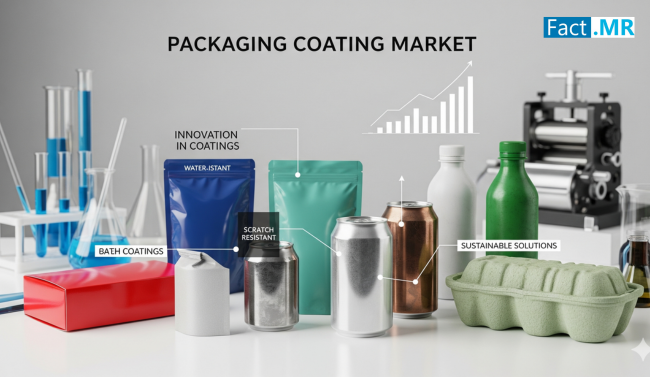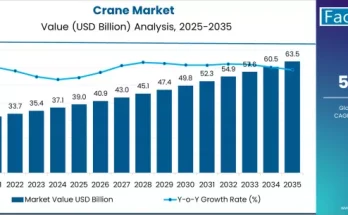The packaging coating market is witnessing significant growth as industries increasingly prioritize product protection, shelf appeal, and sustainability. Packaging coatings are specialized materials applied to packaging surfaces—ranging from paper and cardboard to plastics and metals—to enhance functionality, appearance, and durability. These coatings serve multiple purposes, including barrier protection against moisture, oxygen, and light, as well as providing glossy finishes, matte textures, or antimicrobial surfaces.
Driven by growing consumer expectations for high-quality, safe, and sustainable packaging, the global packaging coating market is poised for robust expansion over the next decade. With manufacturers seeking innovative solutions to meet environmental regulations and evolving supply chain requirements, packaging coatings are becoming a critical component of the packaging industry.
Market Overview
Packaging coatings encompass a variety of technologies, including aqueous coatings, solvent-based coatings, UV-curable coatings, and powder coatings. These coatings improve product shelf life, maintain structural integrity, and ensure consumer safety. The increasing demand for eco-friendly and recyclable packaging has prompted manufacturers to innovate with biodegradable coatings and water-based solutions, minimizing environmental impact without compromising performance.
Key drivers of the market include:
- Rising demand for food and beverage packaging that ensures freshness and hygiene.
- Growing adoption in pharmaceuticals for protective and tamper-evident packaging.
- Expanding e-commerce sector, requiring coatings that prevent damage during transit.
- Regulatory pressures on sustainable and recyclable packaging materials, particularly in North America and Europe.
Segmentation Analysis
The packaging coating market can be segmented based on type, application, end-use industry, and region.
- By Type:
- Aqueous Coatings: Water-based coatings that are eco-friendly and widely used in paper and cardboard packaging.
- Solvent-Based Coatings: Provide high gloss and durability but face regulatory scrutiny due to VOC emissions.
- UV-Curable Coatings: Offer rapid curing times and resistance to abrasion and moisture.
- Powder Coatings: Commonly used in metal packaging to enhance corrosion resistance and aesthetics.
- By Application:
- Food & Beverage Packaging: Ensures freshness and prevents contamination.
- Pharmaceutical Packaging: Provides tamper-evident and protective layers.
- Consumer Goods Packaging: Enhances shelf appeal and brand visibility.
- Industrial Packaging: Focuses on durability and protection during storage and transport.
- By End-Use Industry:
- Food & Beverage
- Pharmaceuticals & Healthcare
- Personal Care & Cosmetics
- Consumer Electronics
- Industrial & Automotive
- By Region:
- North America: Leads adoption due to stringent regulations on food safety and sustainability.
- Europe: Strong focus on eco-friendly coatings and compliance with environmental directives.
- Asia-Pacific: Rapid growth in FMCG, e-commerce, and industrial sectors driving demand.
- Rest of the World: Steady growth in Latin America and the Middle East as packaging standards rise.
Key Trends and Forecast
- Sustainability and Eco-Friendly Coatings:
Increasing environmental awareness has led manufacturers to develop biodegradable, recyclable, and water-based coatings. Companies are actively reducing VOC emissions and adopting coatings that comply with strict packaging waste regulations. - Digital Printing and Smart Packaging Integration:
Packaging coatings are evolving to support digital printing technologies. This allows brands to produce high-resolution images, variable data printing, and anti-counterfeit designs. Smart packaging, including QR codes and NFC-enabled coatings, is enhancing consumer interaction and product tracking. - Functional Coatings:
Innovations in antimicrobial, UV-resistant, and barrier coatings are gaining traction, particularly in the food, pharmaceutical, and healthcare industries. These coatings extend product shelf life, maintain hygiene, and reduce spoilage. - Lightweight and Flexible Packaging:
As e-commerce and on-the-go consumption rise, lightweight coatings for flexible packaging are in demand. These coatings help reduce shipping costs and material usage while maintaining strength and protection. - Regulatory Compliance:
Governments across North America, Europe, and Asia-Pacific are enforcing stricter food safety and environmental regulations, pushing manufacturers to innovate coatings that are safe, recyclable, and sustainable.
Competitive Landscape
The packaging coating market is moderately fragmented, with a mix of global players and regional manufacturers. Companies are focusing on R&D, strategic partnerships, and acquisitions to maintain competitive advantage.
Key Market Players Include:
- BASF SE – Offers a wide range of coatings for industrial, food, and pharmaceutical applications.
- PPG Industries, Inc. – Known for specialty coatings with enhanced durability and sustainability.
- AkzoNobel N.V. – Focuses on eco-friendly solutions and water-based coatings.
- Sherwin-Williams Company – Provides coatings for metal and flexible packaging.
- RPM International Inc. – Offers barrier and protective coatings for diverse industries.
- Nippon Paint Holdings Co., Ltd. – Active in Asia-Pacific, focusing on innovative and sustainable coatings.
These players are investing in eco-innovation, functional coatings, and digital solutions to differentiate themselves in a growing market.
Regional Insights
North America leads adoption due to strong food safety regulations and consumer awareness. Companies are focusing on sustainable coatings, high-performance barrier solutions, and digital printing capabilities.
Europe emphasizes regulatory compliance and environmental sustainability, with increased adoption of water-based and UV-curable coatings.
Asia-Pacific is witnessing the fastest growth due to rising FMCG demand, e-commerce growth, and industrial packaging expansion. Countries like China, India, and Japan are emerging as key markets.
Rest of the World shows steady growth, particularly in Latin America and the Middle East, driven by modernization of packaging standards and consumer demand for high-quality, safe products.
Challenges and Opportunities
Challenges:
- Regulatory pressures on VOC emissions and environmental safety.
- High initial costs of sustainable and specialty coatings.
- Technical complexities in developing functional coatings for diverse packaging materials.
Opportunities:
- Rising demand for eco-friendly packaging in food and beverages.
- Growth in smart packaging solutions integrating digital and anti-counterfeit technologies.
- Expansion of flexible packaging solutions for e-commerce and on-the-go products.
Conclusion
The packaging coating market is set to witness robust growth over the next decade as industries focus on product protection, sustainability, and brand differentiation. Advances in eco-friendly, functional, and smart coatings are creating new opportunities for manufacturers to meet evolving consumer and regulatory demands.
Companies that invest in research, innovation, and sustainability will be well-positioned to capitalize on the growing demand across food & beverage, pharmaceuticals, cosmetics, and industrial packaging segments. With the global shift toward safe, attractive, and environmentally responsible packaging, the packaging coating market is shaping the future of product preservation and consumer engagement.



